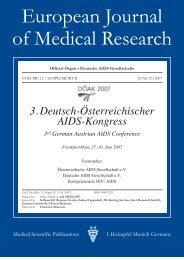alpha-1-antitrypsin deficiency in children: liver disease is not ...
alpha-1-antitrypsin deficiency in children: liver disease is not ...
alpha-1-antitrypsin deficiency in children: liver disease is not ...
- No tags were found...
You also want an ePaper? Increase the reach of your titles
YUMPU automatically turns print PDFs into web optimized ePapers that Google loves.
512 EUROPEAN JOURNAL OF MEDICAL RESEARCHDecember 7, 2005The heterogeneous group of patients with rare variantsof the α1-<strong>antitryps<strong>in</strong></strong> prote<strong>in</strong> shows a broad spectrumof cl<strong>in</strong>ical manifestations. The patients with thephe<strong>not</strong>ypes PiMM procida , PiVZ, and PiM palermo showedno evidence of <strong>liver</strong> <strong>d<strong>is</strong>ease</strong> at the time of diagnos<strong>is</strong>, norat the time of reevaluation. Their serum levels of α1-<strong>antitryps<strong>in</strong></strong> however were below 30% <strong>in</strong> 5 patients, <strong>in</strong>two of them less than 80%. In contrast all patients withthe phe<strong>not</strong>ype PiM(Q0) and the patient with the phe<strong>not</strong>ypePiMP donauwörth had severe <strong>liver</strong> <strong>d<strong>is</strong>ease</strong> at the timeof diagnos<strong>is</strong> (neonatal cholestas<strong>is</strong> <strong>in</strong> 2 patients, neonatalhepatit<strong>is</strong> <strong>in</strong> 3 patients) despite normal levels of α1-<strong>antitryps<strong>in</strong></strong> <strong>in</strong> serum. Two patients with the phe<strong>not</strong>ypePiM(Q0) and the patient with the phe<strong>not</strong>ype PiMPdonauwörthdeveloped rapidly progressive cirrhos<strong>is</strong>. Onlyone out of these 4 patients had normal <strong>liver</strong> functiontests at the time of reevaluation. The results of thevariant groups of patients are summarized <strong>in</strong> Table 2,demonstrat<strong>in</strong>g the cl<strong>in</strong>ical status of the patients at thetime of diagnos<strong>is</strong> and at the time of reevaluation.Unknown environmental factors <strong>in</strong> addition to themodified genes may play a certa<strong>in</strong> role <strong>in</strong> the pathogenes<strong>is</strong>of <strong>liver</strong> <strong>d<strong>is</strong>ease</strong>.DISCUSSIONHomozygous α1-<strong>antitryps<strong>in</strong></strong> <strong>deficiency</strong> (phe<strong>not</strong>ypePiZZ) <strong>is</strong> associated with neonatal cholestas<strong>is</strong> and maylead to cirrhos<strong>is</strong> <strong>in</strong> up to 13% of the affected patients[16, 21]. The heterozygous form of the <strong>d<strong>is</strong>ease</strong> as thephe<strong>not</strong>ypes PiMZ and PiMS rarely co<strong>in</strong>cide with <strong>liver</strong><strong>d<strong>is</strong>ease</strong> but s<strong>in</strong>gle cases of cirrhos<strong>is</strong> are reported <strong>in</strong> theliterature [10, 14]. The homozygous as well as the heterozygousforms of the α1-<strong>antitryps<strong>in</strong></strong> <strong>deficiency</strong> areassociated with low serum levels of α1-<strong>antitryps<strong>in</strong></strong>. Inour series of 48 patients with α1-<strong>antitryps<strong>in</strong></strong> <strong>deficiency</strong><strong>in</strong>clud<strong>in</strong>g 10 patients with rare variants of the <strong>d<strong>is</strong>ease</strong>we found an all over prevalence of <strong>liver</strong> <strong>in</strong>volvement<strong>in</strong> 67% of the patients at the time of diagnos<strong>is</strong>. Thehigh prevalence of <strong>liver</strong> <strong>d<strong>is</strong>ease</strong> <strong>in</strong> our series might beexpla<strong>in</strong>ed by the design of the study. Patients were retrospectivelyevaluated and <strong>liver</strong> <strong>d<strong>is</strong>ease</strong> was the reasonof reduced α1-<strong>antitryps<strong>in</strong></strong> <strong>in</strong> 50 % of the patients.We detected <strong>liver</strong> <strong>in</strong>volvement <strong>in</strong> 58% of our patientswith the PiZ homozygous form of the <strong>d<strong>is</strong>ease</strong>,lead<strong>in</strong>g to end stage <strong>liver</strong> <strong>d<strong>is</strong>ease</strong> <strong>in</strong> 13%. Sveger et al.prospectively screened 200.000 newborns <strong>in</strong> Swedenfor PiZZ α1-<strong>antitryps<strong>in</strong></strong> <strong>deficiency</strong> [19]. They foundcl<strong>in</strong>ical signs of <strong>liver</strong> <strong>d<strong>is</strong>ease</strong> <strong>in</strong> 18% of their patientswith homozygous α1-<strong>antitryps<strong>in</strong></strong> <strong>deficiency</strong> lead<strong>in</strong>g tocirrhos<strong>is</strong> <strong>in</strong> 7%. As the patients <strong>in</strong> our study were referredto our cl<strong>in</strong>ic for diagnostical workup of <strong>liver</strong><strong>d<strong>is</strong>ease</strong> or respiratory abnormalities th<strong>is</strong> might expla<strong>in</strong>the higher prevalence of <strong>liver</strong> <strong>d<strong>is</strong>ease</strong> <strong>in</strong> our patients.However cl<strong>in</strong>ical outcome of our patients was similarto Sveger´s observations. Only 3 of 14 patients (PiZZor PiSZ) had cl<strong>in</strong>ical evidence of <strong>liver</strong> <strong>d<strong>is</strong>ease</strong> 1 - 2years after the diagnos<strong>is</strong> was establ<strong>is</strong>hed. In Sveger´sstudy 25% of the patients with PiZZ showed abnormal<strong>liver</strong> function tests 2 years after diagnos<strong>is</strong> [20]. Allof our patients with PiZZ had low serum levels of α1-<strong>antitryps<strong>in</strong></strong> accord<strong>in</strong>g to the literature. Two of our patientswith homozygous α1-<strong>antitryps<strong>in</strong></strong> <strong>deficiency</strong>were prematurely born <strong>in</strong>fants with neonatal seps<strong>is</strong>.Both <strong>children</strong> developed cirrhos<strong>is</strong>. In a<strong>not</strong>her child <strong>liver</strong>function tests deteriorated dur<strong>in</strong>g a gastro<strong>in</strong>test<strong>in</strong>al<strong>in</strong>fection due to Salmonella enteritid<strong>is</strong> at the age of 2years. Additional factors as parenteral nutrition and severesystemic <strong>in</strong>fections are known as r<strong>is</strong>k factors forthe development of severe <strong>liver</strong> <strong>d<strong>is</strong>ease</strong> <strong>in</strong> these <strong>children</strong>.Environmental factors result<strong>in</strong>g <strong>in</strong> an enhancedsynthes<strong>is</strong> of abnormal α1-<strong>antitryps<strong>in</strong></strong> lead to a higheraccumulation rate of the prote<strong>in</strong> <strong>in</strong> <strong>liver</strong> cells result<strong>in</strong>g<strong>in</strong> <strong>liver</strong> cell damage [12, 13]. These observations supportthe hypothes<strong>is</strong> that <strong>in</strong>tracellular accumulation ofthe mutant prote<strong>in</strong> <strong>in</strong> <strong>liver</strong> cells <strong>is</strong> responsible for <strong>liver</strong><strong>d<strong>is</strong>ease</strong> <strong>in</strong> homozygous α1-<strong>antitryps<strong>in</strong></strong> <strong>deficiency</strong> [11].In adults alcohol consumption and viral hepatit<strong>is</strong> also<strong>in</strong>crease the r<strong>is</strong>k of cirrhos<strong>is</strong> <strong>in</strong> patients with homozygousα1-<strong>antitryps<strong>in</strong></strong> <strong>deficiency</strong> despite normal <strong>liver</strong>function tests dur<strong>in</strong>g childhood [3].15 of 27 patients with heterozygous α1-<strong>antitryps<strong>in</strong></strong><strong>deficiency</strong> showed cl<strong>in</strong>ical evidence of <strong>liver</strong> <strong>in</strong>volvement<strong>in</strong> our series. In 12 of them <strong>liver</strong> function teststurned to normal with<strong>in</strong> 6 months after the time of diagnos<strong>is</strong>.Only 2 of them had slightly elevated transam<strong>in</strong>asesdur<strong>in</strong>g the observation period of 1-3 years. Th<strong>is</strong>co<strong>in</strong>cides with other reports <strong>in</strong> the literature.Heterozygous α1-<strong>antitryps<strong>in</strong></strong> <strong>deficiency</strong> <strong>is</strong> known asbe<strong>in</strong>g associated with an <strong>in</strong>creased r<strong>is</strong>k of neonatalcholestas<strong>is</strong> or neonatal hepatit<strong>is</strong> [1]. However cl<strong>in</strong>icaloutcome of th<strong>is</strong> group <strong>is</strong> different from patients withthe homozygous form of the <strong>d<strong>is</strong>ease</strong>. Only s<strong>in</strong>gle reportsof cirrhos<strong>is</strong> due to heterozygous α1-<strong>antitryps<strong>in</strong></strong><strong>deficiency</strong> ex<strong>is</strong>t [9]. As expla<strong>in</strong>ed previously additionalfactors are necessary to <strong>in</strong>crease the <strong>in</strong>tracellular accumulationof mutant prote<strong>in</strong> <strong>in</strong> <strong>liver</strong> cells. Factors as viralhepatit<strong>is</strong> and alcohol abuse are known to be associatedwith the development of cirrhos<strong>is</strong> even <strong>in</strong> patientswith heterozygous α1-<strong>antitryps<strong>in</strong></strong> <strong>deficiency</strong> [5,9]. In none of our patients cirrhos<strong>is</strong> was observed.However they still are at a higher r<strong>is</strong>k for <strong>liver</strong> <strong>d<strong>is</strong>ease</strong>compared to healthy controls. Eight of 17 <strong>children</strong>with heterozygous α1-<strong>antitryps<strong>in</strong></strong> <strong>deficiency</strong> and abnormal<strong>liver</strong> function tests were breast fed. Perlmutteret al. showed that breast feed<strong>in</strong>g <strong>is</strong> associated with alower r<strong>is</strong>k of mild neonatal cholestas<strong>is</strong> <strong>in</strong> <strong>children</strong> withheterozygous α1-<strong>antitryps<strong>in</strong></strong> <strong>deficiency</strong> [13]. The pathomechan<strong>is</strong>mof th<strong>is</strong> observation <strong>is</strong> still unclear. Liverfunction tests of the 4 patients returned to normalwhen breast feed<strong>in</strong>g was d<strong>is</strong>cont<strong>in</strong>ued.Serum levels of α1-<strong>antitryps<strong>in</strong></strong> ranged betweennormal and 65% of the normal levels adapted to thepatients´age. We did <strong>not</strong> observe any correlation betweenthe serum levels of α1-<strong>antitryps<strong>in</strong></strong> and the appearanceof pathological <strong>liver</strong> function tests <strong>in</strong> patientswith heterozygous α1-<strong>antitryps<strong>in</strong></strong> <strong>deficiency</strong>. Th<strong>is</strong> co<strong>in</strong>cideswith other reports <strong>in</strong> the literature [1, 19].The heterogeneous group of patients with rare mutantsof the α1-<strong>antitryps<strong>in</strong></strong> <strong>deficiency</strong> showed differentcl<strong>in</strong>ical outcome. The rare phe<strong>not</strong>ype PiM(Q0) wasfound <strong>in</strong> 4 patients as diagnosed by <strong>is</strong>oelectric focus<strong>in</strong>g<strong>in</strong> all patients. Two <strong>children</strong> were prematurely born(gestational age 28 weeks and 36 weeks, respectively).Both of them developed severe <strong>liver</strong> <strong>d<strong>is</strong>ease</strong> <strong>in</strong> theirfirst month of live and one child died of progressive<strong>liver</strong> <strong>d<strong>is</strong>ease</strong> with<strong>in</strong> 6 months. Their postnatal periodwas affected by several complications due to prematu-





